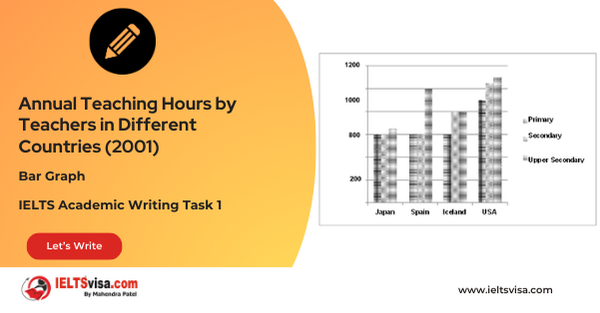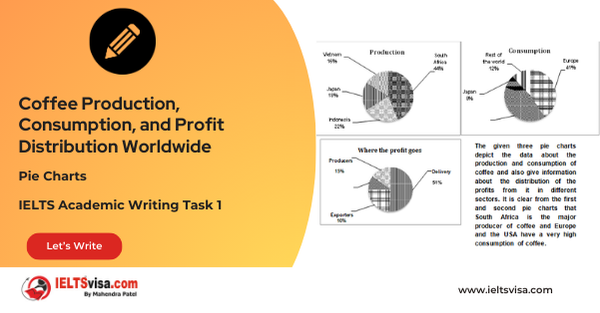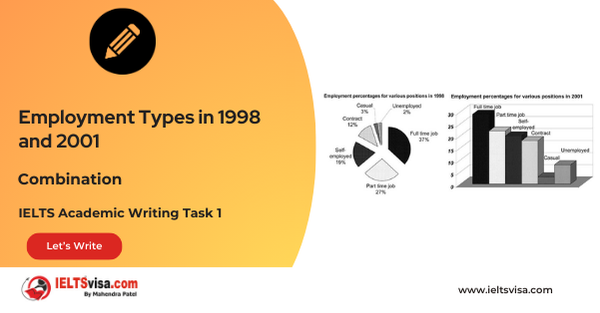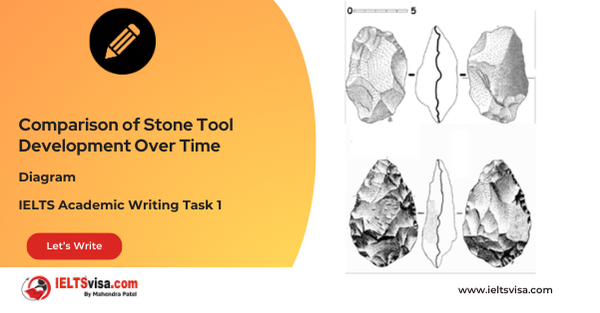The three different kinds of emission sources (oil / coal/ gas) of greenhouse gas in the UK
IELTS Academic Writing Task 1 - Bar Graph
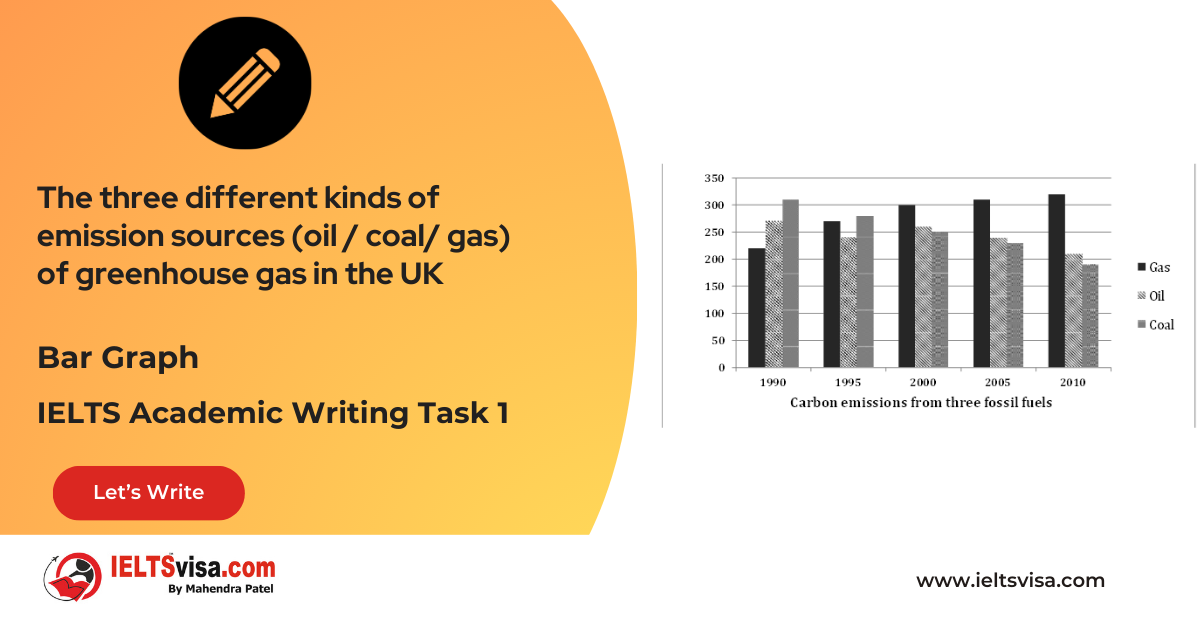
IELTS Writing Task 1 Question
The graph below shows the three different kinds of emission sources (oil / coal/ gas) of greenhouse gas in the UK. Summarise the information by selecting and reporting the main features and make comparisons where relevant.
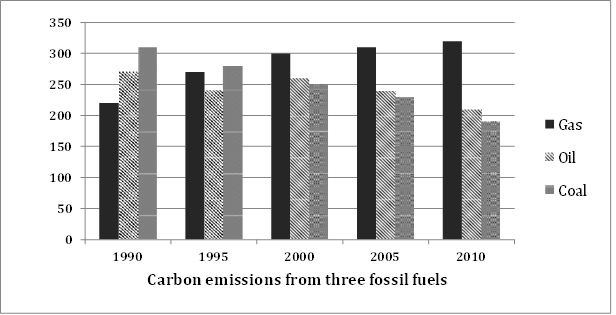
Common Questions for the Bar Graph
1. Graph Type: Bar Chart
2. Title: Greenhouse Gas Emissions by Source in the UK (1990–2010)
3. What are the units of measurement?: Million tons of greenhouse gas emissions
4. Who: Emission sources (gas, oil, coal) in the UK
5. When: 1990 to 2010
6. Where: United Kingdom
7. Topic: Changes in greenhouse gas emissions from three fossil fuels
Comparison Showing and Trends
Comparison 1: Gas Emissions
- Details:
- Emissions increased steadily from 220 million tons in 1990 to 320 million tons in 2010.
2.Became the dominant source of greenhouse gas emissions by 2010.
Comparison 2 : Coal Emissions
- Details:
- Declined significantly from 310 million tons in 1990 to 190 million tons by 2010.
2. The largest decrease among the three sources was shown.
Comparison 3 : Oil Emissions
- Details:
1.Fluctuated between 1990 and 2000 but decreased slowly from 270 million tons in 2000 to 210 million tons in 2010.
Sample Answer
The bar chart illustrates the greenhouse gas emissions from three fossil fuel sources—gas, oil, and coal—in the UK over a two-decade period from 1990 to 2010.
Overall, the data reveals a significant shift in emission patterns, with gas overtaking coal and oil as the leading source of greenhouse gas emissions in the UK by 2010. Coal saw the most substantial decline during the period.
In 1990, coal was the largest source of greenhouse gas emissions at 310 million tons, followed by oil at 270 million tons and gas at 220 million tons. Over the years, gas emissions rose steadily, peaking at 320 million tons in 2010, making it the largest contributor by the end of the period.
Coal emissions, in contrast, decreased sharply, falling from 310 million tons in 1990 to 190 million tons in 2010. Emissions from oil showed fluctuations in the first decade but gradually declined after 2000, dropping from 270 million tons to 210 million tons by 2010.
Top 31 Vocabularies
| Vocabulary | Type | Meaning | Synonyms | Examples |
|
Emissions |
Noun |
Release of substances (e.g., gases) into the atmosphere |
Discharge, Output |
Greenhouse gas emissions from coal decreased sharply. |
|
Fluctuate |
Verb |
To rise and fall irregularly |
Vary, Oscillate |
Emissions from oil fluctuated between 1990 and 2000. |
|
Steadily |
Adverb |
At a constant rate or pace |
Gradually, Continuously |
Gas emissions rose steadily over the two decades. |
|
Dominant |
Adjective |
Having the greatest influence or importance |
Leading, Primary |
Gas became the dominant source of emissions by 2010. |
|
Decline |
Noun/ Verb |
A gradual reduction or decrease |
Drop, Reduction |
Coal emissions declined significantly over the period. |
|
Emission |
Noun |
The release of gases or substances into the atmosphere |
Discharge, Release, Output |
“The emission of greenhouse gases has been rising steadily.” |
|
Fossil Fuel |
Noun |
A natural fuel derived from the remains of living organisms |
Hydrocarbon, Natural fuel |
“Coal, oil, and gas are fossil fuels that contribute to emissions.” |
|
Shift |
Noun |
A significant change or movement in a particular direction |
Change, Adjustment, Transition |
“There was a shift in the leading source of emissions.” |
|
Substantial |
Adjective |
Considerable in quantity, size, or degree |
Significant, Considerable, Major |
“Coal saw a substantial decline in emissions.” |
|
Peak |
Verb |
To reach the highest point or maximum level |
Surge, Climb, Reach |
“Gas emissions peaked in 2010.” |
|
Decline |
Verb |
To decrease in amount, quality, or strength |
Drop, Diminish, Decrease |
“Emissions from coal declined significantly over the period.” |
|
Contribute |
Verb |
To give or add something to a larger whole |
Add, Provide, Supply |
“Gas contributed the most to greenhouse gas emissions by 2010.” |
|
Gradually |
Adverb |
Slowly over a period of time |
Steadily, Progressively |
“Gas emissions increased gradually throughout the years.” |
|
Fluctuation |
Noun |
Irregular rising and falling over time |
Variability, Oscillation, Change |
“Oil emissions experienced fluctuations in the first decade.” |
|
Rate |
Noun |
The speed or frequency at which something occurs |
Pace, Speed, Frequency |
“The rate of emissions decreased for coal over the years.” |
|
Source |
Noun |
A place, origin, or means from which something comes |
Origin, Cause, Provider |
“Gas became the largest source of emissions by 2010.” |
|
Contribute |
Verb |
To help bring about or cause something |
Aid, Assist, Help |
“Gas was the largest contributor to greenhouse gas emissions.” |
|
Gradual |
Adjective |
Occurring slowly or over a long period of time |
Progressive, Steady, Slow |
“Emissions from oil gradually decreased after 2000.” |
|
Fluctuating |
Adjective |
Changing irregularly, rising and falling |
Varying, Unstable, Shifting |
“The fluctuating emissions from oil were unpredictable.” |
|
Significant |
Adjective |
Of great importance or consequence |
Major, Notable, Considerable |
“A significant decline in coal emissions occurred.” |
|
Steep |
Adjective |
A sharp or dramatic increase or decrease |
Sharp, Sudden, Dramatic |
“There was a steep decline in coal emissions.” |
|
Period |
Noun |
A length of time in which something happens |
Interval, Span, Duration |
“Over the period of 20 years, emissions saw changes.” |
|
Overtake |
Verb |
To surpass in importance, amount, or speed |
Surpass, Outpace, Eclipse |
“Gas overtook coal as the leading source of emissions.” |
|
Trend |
Noun |
A general direction in which something is developing |
Pattern, Movement, Tendency |
“There was a trend of declining emissions from coal.” |
|
Stabilize |
Verb |
To make or become stable or steady |
Balance, Secure, Equalize |
“Gas emissions stabilized after peaking in 2010.” |
|
Convergence |
Noun |
The process of coming together or merging |
Union, Merging, Intersection |
“The convergence of gas emissions with coal marks a shift.” |
|
Decrease |
Verb |
To make or become smaller or less |
Diminish, Lessen, Drop |
“The decrease in coal emissions was substantial.” |
|
Proportion |
Noun |
A part or portion of something |
Share, Fraction, Percentage |
“The proportion of gas emissions increased significantly.” |
|
Volatility |
Noun |
The quality of being unstable or unpredictable |
Instability, Fluctuation |
“Oil emissions showed volatility in the early years.” |
|
Contraction |
Noun |
A process of becoming smaller or more compact |
Reduction, Shrinking |
“There was a contraction in the volume of coal emissions.” |
|
Increase |
Verb |
To become greater or larger |
Grow, Rise, Amplify |
“Gas emissions increased over the period.” |

Our Books
Master IELTS Speaking Part 1
IELTS Writing Task 1 Book
IELTS Writing Task 2 Book
Writing Task 1 Question Types
Practice IELTS Other Modules
IELTS Listening
The IELTS Listening test assesses how well you can understand spoken English in various contexts. It lasts about 30 minutes and is divided into four sections with a total of 40 questions. The listening tasks become increasingly difficult as the test progresses.
IELTS Academic Reading
The IELTS Academic Reading section assesses your ability to understand and interpret a variety of texts in academic settings. It is designed to evaluate a range of reading skills, including skimming for gist, reading for main ideas, reading for detail, understanding inferences, and recognizing a writer's opinions and arguments.
IELTS Speaking
The IELTS Speaking test assesses your ability to communicate in English on everyday topics. It lasts 11-14 minutes and consists of three parts: introduction, cue card, and a discussion based on the cue card topic.
IELTS General Reading
IELTS General Reading tests your ability to understand and interpret various types of texts. Here are some key areas and types of content you can expect to encounter in the reading section, along with tips for effective preparation.
IELTS Academic Writing Task 1
In IELTS Academic Writing Task 1, you are presented with a visual representation of information, such as graphs, charts, tables, or diagrams, and you are required to summarize, compare, or explain the data in your own words.
IELTS General Writing Task 1
In IELTS General Writing Task 1, you are required to write a letter based on a given situation. The letter can be formal, semi-formal, or informal, depending on the prompt. Here’s a breakdown of the key components to include in your letter
IELTS Academic Writing Task 2
In IELTS Academic Writing Task 2, you are required to write an essay in response to a question or topic. Here’s a guide to help you understand the essential elements of this task
IELTS Exam Tips
To succeed in the IELTS exam, practice regularly, familiarize yourself with the test format, improve your vocabulary, develop time management skills, and take mock tests to build confidence.
Grammer for IELTS
Grammar is the foundation of effective communication in English. Understanding tense usage, subject-verb agreement, and sentence structure enhances clarity and coherence in writing and speaking.
Vocabulary for IELTS
Vocabulary plays a crucial role in the IELTS (International English Language Testing System) exam, especially in the Speaking and Writing sections. Here’s an overview of why vocabulary is important and how it impacts your performance
RECENT IELTS SAMPLES QUESTIONS AND ANSWERS
Task 1 – Column graph – Percentage of Young People Enrolled in Universities in 2000 and 2007.
20:00 Start Pause Stop [df_adh_heading title_infix="IELTS Writing Task 1 Question" use_divider="on"...
Task 1 – Bar Graph – Annual Teaching Hours by Teachers in Different Countries (2001)
20:00 Start Pause Stop [df_adh_heading title_infix="IELTS Writing Task 1 Question" use_divider="on"...
Task 1 – Pie Charts – Coffee Production, Consumption, and Profit Distribution Worldwide
20:00 Start Pause Stop [df_adh_heading title_infix="IELTS Writing Task 1 Question" use_divider="on"...
Task 1 – Column graph – Types of Transport Used by Tourists Visiting New Zealand from Five Countries in 2004.
20:00 Start Pause Stop [df_adh_heading title_infix="IELTS Writing Task 1 Question" use_divider="on"...
Task 1 – Bar and Pie Chart Combination – Employment Types in 1998 and 2001
20:00 Start Pause Stop [df_adh_heading title_infix="IELTS Writing Task 1 Question" use_divider="on"...
Task 1 – Diagram – Comparison of Stone Tool Development Over Time
20:00 Start Pause Stop [df_adh_heading title_infix="IELTS Writing Task 1 Question" use_divider="on"...


